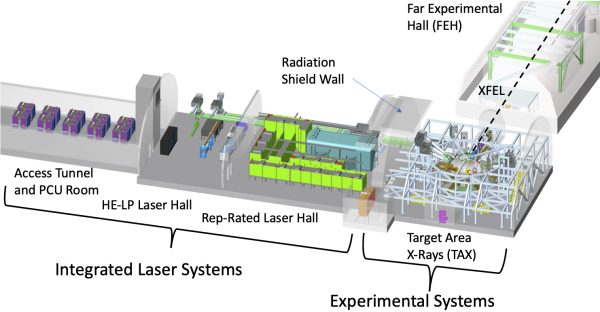MEC-U
Contact
Alan Fry
Project Director
(650) 926-7422
alanfry@slac.stanford.edu
Gilliss Dyer
Chief Scientist
(650) 926-3414
gilliss@slac.stanford.edu

The Matter in Extreme Conditions (MEC) upgrade project to combine a high-power petawatt (PW) laser and a high-energy kilojoule (kJ) laser with Linac Coherent Light Source (LCLS), the world’s leading X-ray free-electron laser, promises to dramatically improve our understanding of matter in extreme conditions, with applications in energy generation, national security, isotope production and medical technology, and ensure U.S. leadership in this important field.
The MEC Upgrade (MEC-U) project will build a new major laser facility at LCLS, built on the success of the Matter in Extreme Conditions (MEC) instrument. This laser facility will significantly increase the power of the high intensity laser system to the petawatt class, increase the energy of the shock-driver laser to hundreds of Joules, and expand the capabilities of the MEC instrument to support groundbreaking experiments enabled by the combination of high power lasers with the world’s brightest X-ray source.

The MEC Petawatt Upgrade facility will be located in a new, dedicated underground cavern allowing two state-of-the-art laser systems to be combined with LCLS, with two experimental areas dedicated to the study of matter in extreme conditions.
Details are available in the report: MEC-U Conceptual Design Report (SLAC-R-1152 or https://doi.org/10.2172/1866100).
Project timeline:
CD-0 Approved on January 4, 2019
CD-1 Approved on October 4, 2021
The MEC-U project is funded by DOE Office of Science’s Fusion Energy Sciences (FES). SLAC is partnering with Lawrence Livermore National Laboratory (LLNL) and University of Rochester’s Laboratory for Laser Energetics (LLE) to design and construct the facility.

A National Opportunity

A 2017 report of the National Academy of Sciences and Engineering, “Opportunities in Intense Ultrafast Lasers: Reaching for the Brightest Light,” pointed out the importance of this field of science and recommended that DOE secure a key global advantage for the U.S. through “co-location of high-intensity lasers with existing infrastructure such as particle accelerators.” This project directly responds to that recommendation.
Building on Success
Petawatt lasers generate matter at the high temperatures and pressures found in cosmic collisions, the cores of stars and planets, and fusion devices. But today’s petawatt lasers are standalone facilities, with limited ability to adequately diagnose or understand the extreme conditions they produce.
LCLS’s Matter in Extreme Conditions (MEC) instrument, funded by DOE Fusion Energy Sciences (FES), was built in 2012 to enable exquisite studies of extreme conditions created by an intermediate-power optical laser. These experiments have delivered a wealth of outstanding science and attracted worldwide media attention. A petawatt laser will provide access to the hotter, denser, more dynamic plasmas needed to address the most important scientific challenges identified by the broad user community. It will also leverage the LCLS-II upgrade to the LCLS accelerator complex, which will provide X-ray laser beams of unsurpassed brilliance for probing those plasmas.
New Scientific Frontiers
Petawatt laser research at LCLS will provide essential tools for:
- Creating and measuring extreme plasma conditions to understand and predict the behaviors needed to produce fusion energy, and replicate astrophysical phenomena here on Earth.
- Understanding warm dense matter – a state that defies current theories of matter. It is found in the cores of giant gas planets, the atmospheres of white dwarfs and the critical early phase of inertial confinement fusion capsule implosions.
- Creating and studying extreme pressures like those found in meteor impacts and in the Earth’s dense core, helping research into world-changing events on our planet.
The new facility will also transform our understanding of extreme plasmas; aid the development of technologies for national security, science, medicine, and inertial fusion energy (IFE); enable laser-driven charged particle acceleration; and provide key evidence to explain vexing astrophysical phenomena, such as the origin of cosmic rays.
Keeping the U.S. Out Front
When it opened in 2012, the MEC instrument at LCLS was the only one of its kind in the world. But high-power laser systems are now being coupled with LCLS-like facilities in Germany (European XFEL) and Japan (SACLA). In addition, Europe’s Extreme Light Infrastructure (ELI) facility will produce several laser systems at or above 1 petawatt power, while China recently announced bold plans in this field for mid-decade deployment. The proposed, expandable MEC Petawatt Upgrade facility, which presents opportunities for new laser technology development, would maintain our leadership position for many years to come.

